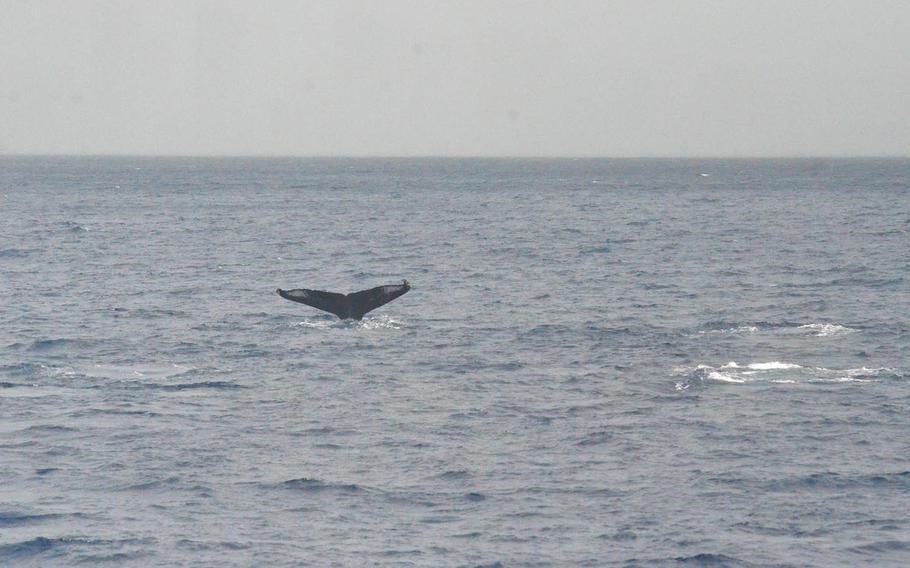
A humpback whale dives into waters just off Waikiki Beach, Hawaii, offering a view of the white tail markings that are distinctive to the species. (Wyatt Olson/Stars and Stripes)
Just like frigid tourists who flock to Hawaii for a winter getaway, so too do humpback whales head to the Rainbow State this time of year.
Beginning in December, they arrive from the north Pacific to the warm waters of Hawaii, the only U.S. state where they mate, calve and nurse their young.
They spend the winter months frolicking in the clear waters of the Hawaiian Islands, and watching the 45-ton adults cavort is among the top attractions for visitors and residents alike.
You can see them from a number of shoreline vistas, but for serious whale-watching you need to get on a boat.
Several companies offer cruises from Oahu, with the excursions usually lasting a few hours and including a meal.
Atlantis Adventures’ 150-foot Majestic boat offers a comfortable view from an enclosed second-level deck through wide, panoramic windows. It departs near downtown Honolulu, a short distance from Waikiki Beach.
The enclosed deck is essential because it can get downright cold on the outdoor viewing platforms as the boat zips along — more so if there’s a winter drizzle coming down.
But you’ll want to go to the open bow of the ship once the captain spots the telltale sign of a humpback: the 20-foot-high blast of seawater from the surface out of the whale’s blowhole.
By law, ships aren’t allowed to get closer than 100 yards to the whales, but the gentle beasts don’t follow the law and sometimes get closer than that to the boat. Once the captain has slowed or stopped the boat, it becomes a waiting game for the whale — or whales, as they are often in groups — to come up for air every 10 to 15 minutes for adults, 3 to 5 minutes for calves.
When they do come up for a breath, they usually arch headfirst over the surface, then dive so that their tails stick straight up. (Humpback trivia: the all-gray whales have white markings on their tail that are as unique and individual as our fingerprints.)
If you’re lucky, you’ll see — and hear — a tail slap, a splash that generally serves as a warning sign. Or you might see the mother of all antics, the “breach,” in which the whale launches itself entirely out of the water and splashes down spectacularly.
It's best to bring a pair of binoculars or a camera with a telephoto lens. Once you've gauged the vicinity of an area of activity with the naked eye, keep watch through the lens for their return to the surface
Conventional wisdom holds that a calm, clear day is best for spooting whales, and as far as visibility goes, that's probably true. But the best, busiest whale-watching excursion I've ever been on was aboard the Majestic during a miserable day of high wind and almost constant rain.
Groups of males were constantly jostling each other in contests of mating superiority. They were fast-moving, sometimes breaking throught the water suprisingly close to the boat.
Still, even then I didn't see a breach.
Humpbacks were hunted almost to extinction by the beginning of the 20th century. They remain an endangered species but are making a comeback.
In 1993, there were an estimated 6,000 whales in the northern Pacific Ocean, with about 4,000 of those regularly wintering in Hawaiian waters, according to the U.S. National Oceanic and Atmospheric Administration.
Today, more than 10,000 whales make Hawaii their primary wintering waters, NOAA said.
Humpbacks also winter near western Mexico and around the islands of southern Japan, migrating as far as 3,000 miles. They swim almost continuously at 3 to 7 mph.
Instead of teeth, humpbacks have bristles called baleen in their mouths, which capture the tiniest of food, such as krill and herring.
Humpbacks spend more than 90 percent of their lives under water, and as you stand aboard the Majestic, you'll probably swear it's more like 99 percent.
But it's that scarcity that makes it so memorable when one arches its back gracefully out of the water, flips its tail into the air and then disappears once again into the deep where it spends so much of its life.